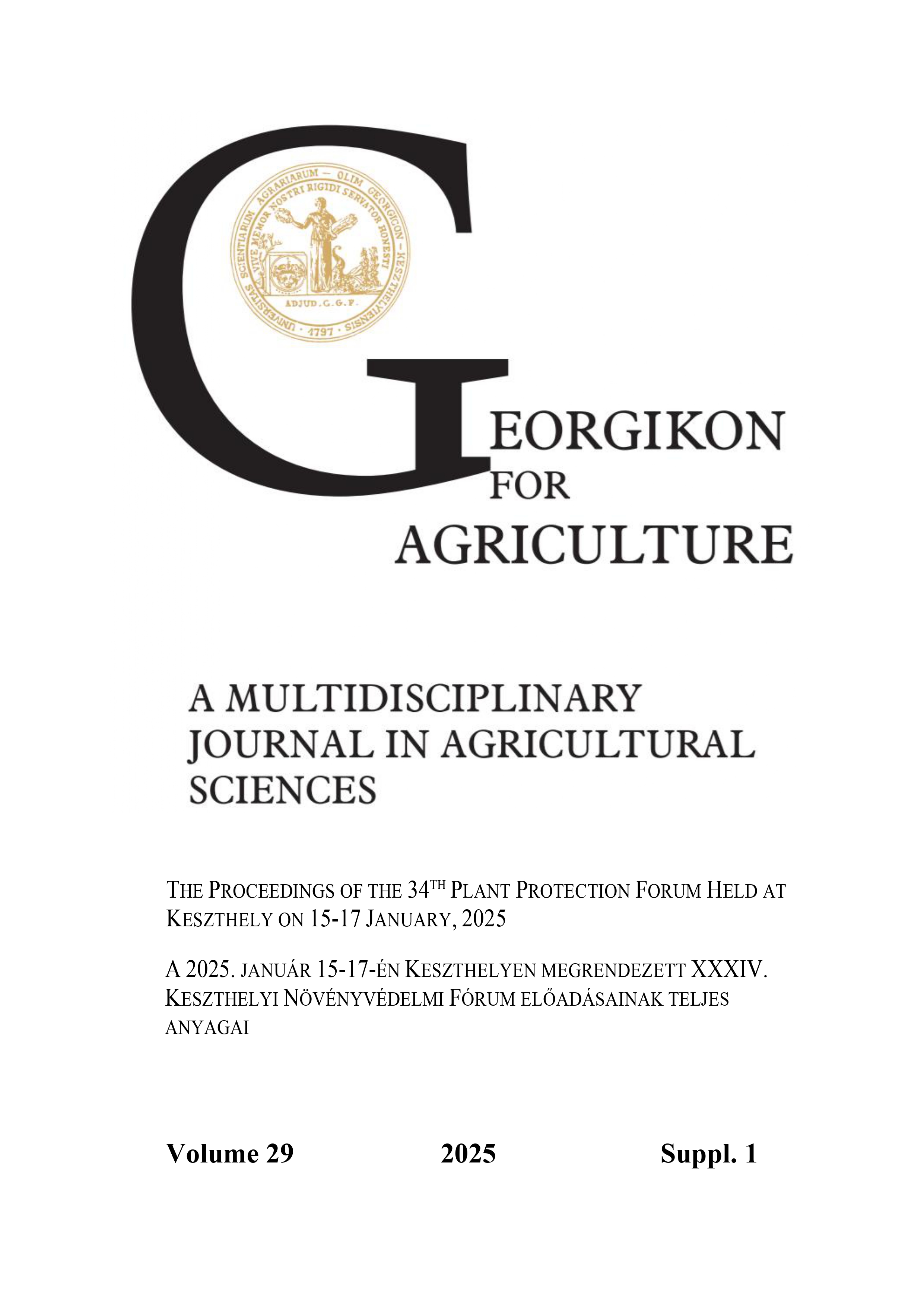Impact of crop site geographic altitude on drought indices of field crops in Hungary
DOI:
https://doi.org/10.70809/6565Keywords:
field crops, altitude, crop site, drought, vulnerabilityAbstract
Growth and development of field crops is highly influenced by the water availability of the crop site. In an assessment study at the MATE University, the magnitude of aridity in relation with the geographic location of the crop site has been evaluated. Six field crop species (Sugar beet Beta vulgaris, winter barley Hordeum vulgare, winter wheat Triticum aestivum, maize Zea mays, potato Solanum tuberosum, and alfalfa Medicago sativa) were involved in the research. Data bases of twelve meteorological stations (Békéscsaba, Budapest, Debrecen, Miskolc, Mosonmagyaróvár, Nagykanizsa, Nyíregyháza, Pécs, Siófok, Szeged, Szolnok, Szombathely) representing major geographic areas of Hungary were used in the evaluation. PAI indices of the stations involved were combined with vulnerability indices of the field crops studied. Upon the results of the study cereals proved to be the most tolerant, while potato and maize were highly influenced by aridity x vulnerability interactions. Considerable impact could be seen in the case of alfalfa and sugar beet. The geographic altitude of the crop site was in negative correlation with the magnitude of drought indices.
References
Bihari, Z. (ed). 2012. Délkelet-Európai Transznacionális Együttműködési Program. (South-East Europen Transnational Cooperation Programme). Országos Meteorológiai Szolgálat. Budapest. https://www.met.hu/doc/DMCSEE/DMCSEE_zaro_kiadvany.pdf
FAO 2021. The State of the World’s Land and Water Resources for Food and Agriculture – Systems at breaking point (SOLAW 2021) Synthesis report 2021. https://doi.org/10.4060/cb7654en
Jolánkai, M., Gyuricza, Cs., Tarnawa, Á., Pósa, B., Birkás, M. 2012. A drought assessment survey of Hungarian soils. Proceedings. 47th Croatian – 7th International Symposium on Agriculture. Ed.: M. Pospišil. Opatija. 492–496 pp.
KSH 2022. Főbb növényi kultúrák terméseredményei. Crop yield of main field crops in Hungary. https://www.ksh.hu/docs/hun/xftp/stattukor/fobbnoveny/2020/index.html
Lakatos, M., Szalai, S. 2010. Aszályindex-számítás és –térképzés Magyarországra a DMCSEE keretében, Drought indexing and mapping in Hungary by DMCSEE. Agrofórum. 21 (8) 49–51.
OMSZ 2022. Average annual precipitation and annual mean temperature. https://www.met.hu/eghajlat/magyarorszag_eghajlata/altalanos_eghajlati_ jellemzes/csapadek/
Pálfai, I., 1990. Description and forecasting of droughts in Hungary. Proc. of 14th Congress on Irrigation and Drainage (ICID), Rio de Janeiro, 1990, Vol. 1-C, 151–158.
Tarnawa, Á., Gyuricza, Cs., Máté, A., Sallai, A., Pósa, B., Jolánkai M. 2012. A drought assessment survey based on the evapotranspiration balance of major field crops in Hungary. In: Transport of water, chemicals and energy in the soil-plant-atmosphere system. Ed.: A. Celková. UH SAV. Bratislava. 786–791.
Tarnawa, Á., Klupács, H., Sallai, A., Szalay, K., Kassai, M.K., Nyárai, H.F., Jolánkai, M. 2010. Study on the impact of main climatic factors of crop production in a mathematical model. In: Transport of water, chemicals and energy in the soil-plant-atmosphere system. Ed: A. Celková. Institute of Hydrology, Bratislava, 566–571.
UNEP 1992. World Atlas of Desertification. A global overview on geography. https://wedocs.unep.org/handle/20.500.11822/42137
Várallyay, G. 2006. Soil degradation processes and extreme soil moisture regime as environmental problems in the Carpathian Basin. Agrokémia és Talajtan. 55 (1–2) 9–18. https://doi.org/10.1556/agrokem.55.2006.1.2
Vermes L. (ed.) 2011. Aszálystratégia (Drought strategy). Manuscript VM, Budapest.
Downloads
Published
Issue
Section
License
Copyright (c) 2025 M. Kassai Katalin, Kende Zoltán, Tarnawa Ákos, Jolánkai Márton

This work is licensed under a Creative Commons Attribution-NonCommercial-NoDerivatives 4.0 International License.
Cikkre a Creative Commons 4.0 standard licenc alábbi típusa vonatkozik: CC-BY-NC-ND-4.0. Ennek értelmében a mű szabadon másolható, terjeszthető, bemutatható és előadható, azonban nem használható fel kereskedelmi célokra (NC), továbbá nem módosítható és nem készíthető belőle átdolgozás, származékos mű (ND). A licenc alapján a szerző vagy a jogosult által meghatározott módon fel kell tüntetni a szerző nevét és a szerzői mű címét (BY).




